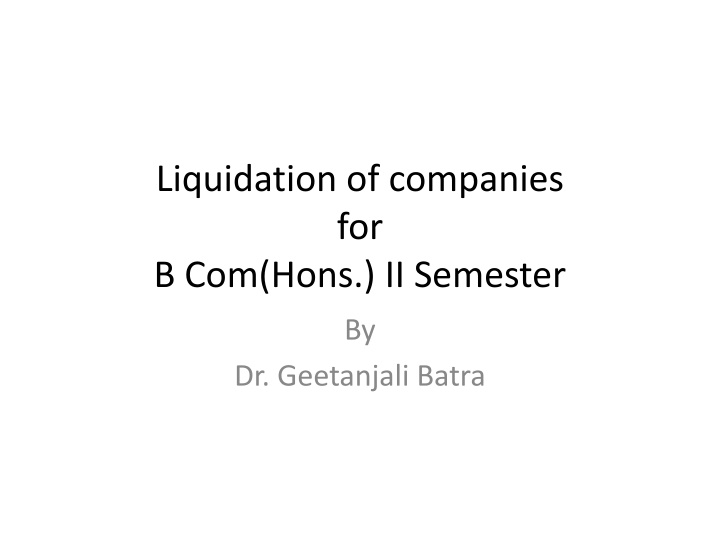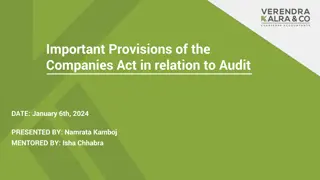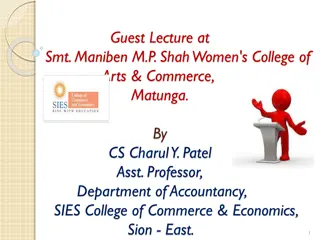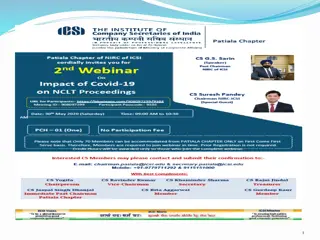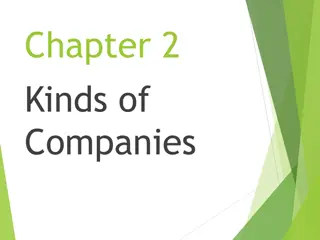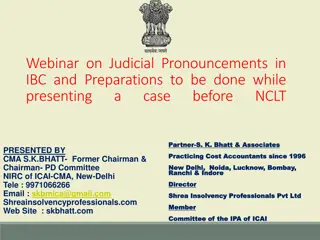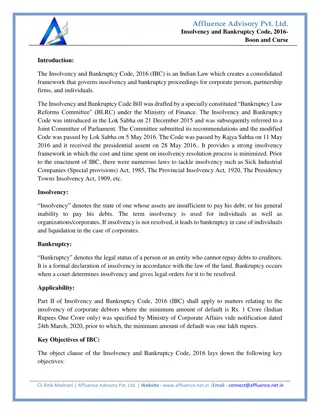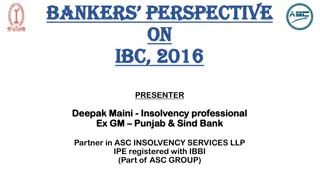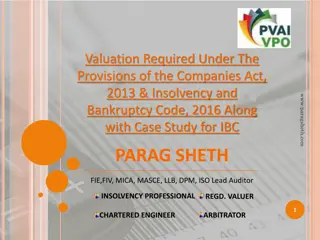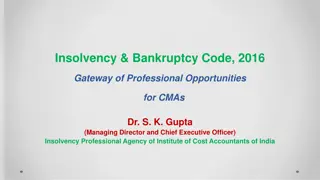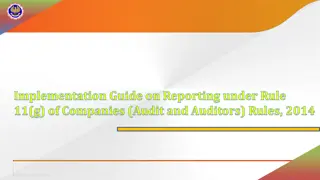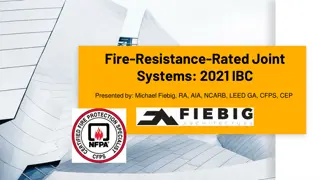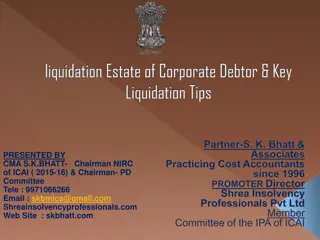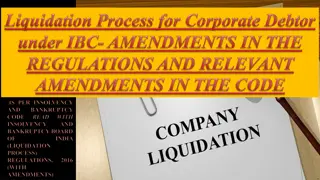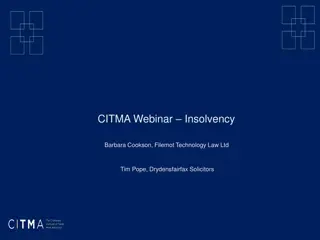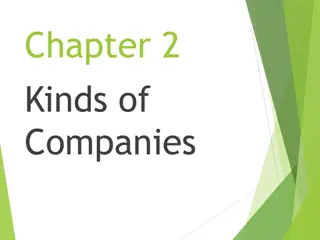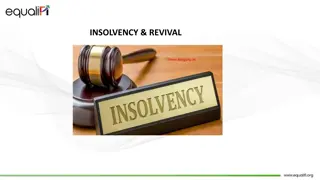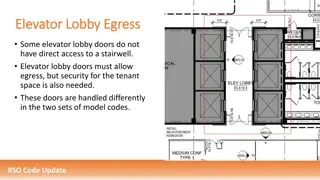Liquidation of Companies: Procedures as per IBC 2016
The process of liquidating a company involves collecting and selling its assets to pay off debts, with remaining funds distributed to shareholders. Under the Insolvency and Bankruptcy Code (IBC) 2016, specific procedures must be followed, including initiation by either creditors or debtors within set timeframes, oversight by the Insolvency and Bankruptcy Board of India, and adherence to resolution deadlines based on the type and size of the organization.
Download Presentation

Please find below an Image/Link to download the presentation.
The content on the website is provided AS IS for your information and personal use only. It may not be sold, licensed, or shared on other websites without obtaining consent from the author.If you encounter any issues during the download, it is possible that the publisher has removed the file from their server.
You are allowed to download the files provided on this website for personal or commercial use, subject to the condition that they are used lawfully. All files are the property of their respective owners.
The content on the website is provided AS IS for your information and personal use only. It may not be sold, licensed, or shared on other websites without obtaining consent from the author.
E N D
Presentation Transcript
Liquidation of companies for B Com(Hons.) II Semester By Dr. Geetanjali Batra
This presentation talks about following questions Q1. Discuss the winding up procedures as per IBC, 2016. Q2. What is Liquidators statement of account ? Discuss the order of receipts and payments in Liquidators statement of account. Q3. Compare provisions of AS 14 with IND AS 103
Winding up of a company The winding up or liquidation of a company is the process by which a company's assets are collected and sold in order to pay its debts. Any money remaining after all debts, expenses and costs have been paid off are distributed amongst the shareholders of the company
Types of winding up of a company Winding up as per The Companies Act, 2013 OR Liquidation under Insolvency and Bankruptcy Code, 2016 (IBC 2016)
IBC 2016 The Code, 2016 (IBC) is the bankruptcy law of India seeks to consolidate framework by single law for insolvency and bankruptcy Insolvency and Bankruptcy the existing creating a
Procedures as per IBC, 2016 1. Initiate the Process: It is possible to initiate the procedure either by the creditors or the debtors. Maximum time to complete procedure: The code lays down a maximum time period for completing the insolvency resolution procedure for individuals and corporates. In the case of a company, the procedure must be fully completed in one hundred and eighty days, which can later be stretched by ninety days only when a large percentage of creditors permit or agree. On the other hand, in the case of start-ups (aside to the partnership companies), small organizations as well as other organizations (having less than Rs 1 crore worth of assets), the resolution procedure would be fulfilled within a period of ninety days of initiating the required that can be further stretched by as many as 45 days. 2.
Procedures as per IBC, 2016 3. Regulator of Insolvency: Insolvency and Bankruptcy Board of India shall oversee the proceedings related to insolvency in the nation and also regulate all the organizations that have been registered by the board. The Insolvency and Bankruptcy Board shall consist of ten members, which would also include the representatives of the Law and Finance ministries as well as the RBI (Reserve Bank of India).
Procedures as per IBC, 2016 4. Licensed Insolvency Professionals: Insolvency procedure shall be managed by licensed insolvency professionals. They would also exercise control on the debtor s assets at the time of the insolvency procedure.
Procedures as per IBC, 2016 5. Insolvency and Bankruptcy Adjudicator: The Code has introduced two distinct tribunals for overseeing the procedure resolving insolvency, for companies and individuals. These are (i) the National Company Law Tribunal for organizations and Limited Liability Partnership companies; as well as (ii) the Debt Recovery Tribunal for overseeing insolvency resolution for individuals as well as partnership firms.
Procedures as per IBC, 2016 6. Steps as per IBC, 2016: An insolvency plea is given to the authority that adjudicates (in corporate debtor s case it is NCLT) by operation or financial creditors or the corporate debtor. The plea can be accepted or rejected in a maximum time period of fourteen days. In case the plea gets acceptance then the tribunal will have to quickly appoint an IRP or Insolvency Resolution Professional for drafting a plan of resolution within a period of 180 days (that can be extended by ninety days). The court would initiate the process of resolving corporate insolvency. During that particular period, the company s directors shall remain suspended whereas the promoters shall have no say in the company management. Insolvency Resolution Professional can seek help of the management of the company for handling everyday operations. In case the Insolvency Resolution Professional is unable to revive the organization, then the process of liquidation shall be initiated.
Liquidators statement of account The the liquidator showing receipts and payments of cash in case of voluntary winding up is called Liquidators' statement of account There is no double entry involved in the preparation of liquidator s account. It is only a statement though presented in the form of an account. statement prepared by statement of
Liquidators statement of account Liquidator s statement of account of the winding up is prepared for the period commencement of winding up to the close of winding up. If winding up of company is not concluded within one year after its commencement, statement of account pursuant to section 551 of the Companies Act, 1956 (Form No. 153) is to be filed by a Liquidator within a period of two months of the conclusion of one year and thereafter until the winding up is concluded at intervals of not more than one year or at such shorter intervals, if any, as may be prescribed. starting from the Liquidator s
Receipts are shown in the following order in liquidator s statement of account 1. In case of assets specifically pledged in favour of creditors, only the surplus from it, if any, is entered as surplus from securities . In case of partly paid up shares, the equity shareholders should be called up to pay necessary amount (not exceeding the amount of uncalled capital) if creditors claims/claims of preference shareholders can t be satisfied with the available amount. Preference shareholders would be called upon to contribute (not exceeding the amount as yet uncalled on the shares) for paying of creditors. Amounts received from calls to contributories made at the time of winding up are shown on the Receipts side. Receipts per Trading Account are also included on the Receipts side. Payments made to redeem securities and cost of execution and payments per Trading Account are deducted from total receipts. 2. 3. 4. 5.
Payments are made and shown in the following order A) Legal charges; B) Liquidator s expenses; D) Debenture holders (including interest up to the date of winding up if the company is insolvent and to the date of payment if it is solvent); E) Creditors: 1. Preferential (in actual practice, preferential creditors are paid before debenture holders having a floating charge); 2. Unsecured creditors; F) Preferential shareholders (Arrears of dividends on cumulative preference shares should be paid up to the date of commencement of winding up); and G) Equity shareholders.
Comparison of AS-14 and IND AS 103 Ind AS 103 defines business combination which has a wider scope whereas the existing AS 14 deals only with amalgamation. Under the existing AS 14 there are two methods of accounting for amalgamation. The pooling of interest method and the purchase method. Ind AS 103 prescribes only the acquisition method for each business combination. Under the existing AS 14, the acquired assets and liabilities are recognized at their existing book values or at fair values under the purchase method. Ind AS 103 requires the acquired identifiable assets liabilities and non-controlling interest to be recognized at fair value under acquisition method. Ind AS 103 requires that for each business combination, the acquirer shall measure any non- controlling interest in the acquiree either at fair value or at the non-controlling interest s proportionate share of the acquiree s identifiable net assets. On other hand, the existing AS 14 states that the minority interest is the amount of equity attributable to minorities at the date on which investment in a subsidiary is made and it is shown outside shareholders equity. Under Ind AS 103, the goodwill is not amortized but tested for impairment on annual basis in accordance with Ind AS 36.The existing AS 14 requires that the goodwill arising on amalgamation in the nature of purchase is amortized over a period not exceeding five years. Ind AS 103 deals with reverse acquisitions whereas the existing AS 14 does not deal with the same.
Link for syllabus guidelines http://commerce.du.ac.in/web/uploads/news /Minutes%20of%20Guidelines%20meeting%2 0of%20BCom%20(Hons)%20Semester%20II%2 0paper%20titled%20- Corporate%20Accounting%20BCH%202_2%20 under%20CBCS.pdf
